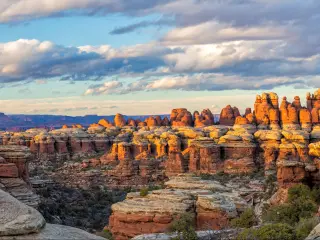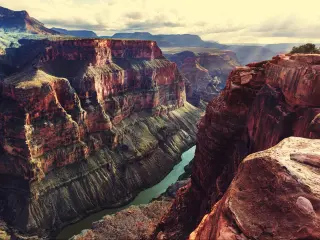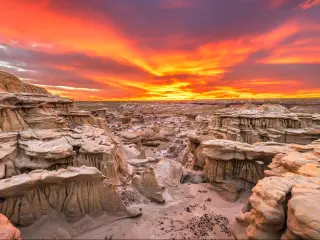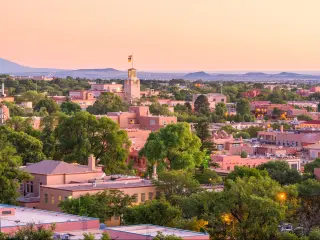Route 66 vs I-40: which is better for a road trip? (With map!)
Historic Route 66 and Interstate 40 both take you on stunning cross-country road trips, passing through unforgettable cities and landscapes in several states. So, if you're looking for an epic long-distance road trip across the United States, chances are these routes will be at the top of your list.
The 2,180-mile historic Route 66 runs between California and Chicago, through the Arizona desert. Starting in Barstow, I-40 follows a similar route as far as Oklahoma City, then continues east towards North Carolina through Memphis and Nashville.
The two routes have a lot in common, since they run parallel for hundreds of miles, so keep on reading to find out whether it's Route 66 or I-40 that will make the perfect choice for your road trip.
Route 66 or I-40: which route should you drive?
Route 66 is a historic route that took travelers west in search of a new life after the Great Depression. With its place in 20th-century history and the varied landscapes that it crosses, it's become an iconic drive that's helped shape cultural legends.
Traditionally traveled from east to west, it's possible to imagine the challenges that faced travelers in the 1930s and 40s before the interstate turned the route into a much more streamlined journey.
The original Route 66 no longer exists – it's been bypassed by the faster interstate (or sometimes built over) but sections are still drivable, particularly from Seligman in Arizona. In many places, you can change between the nearby interstate and the original highway as much as you like.
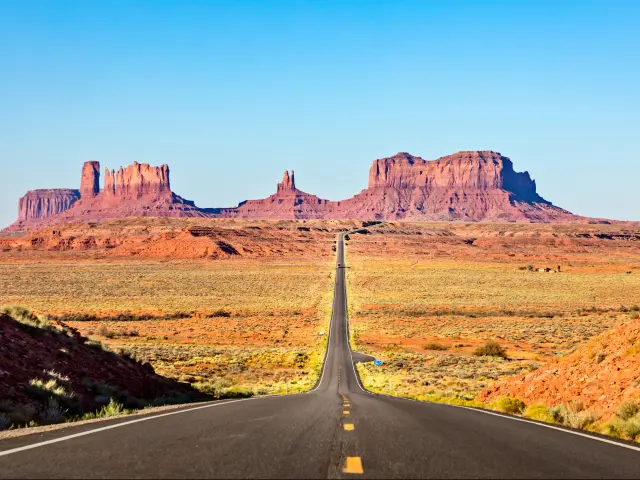
Although it isn't such a legendary route as Route 66, I-40 also offers a superb cross-section of the United States that's packed full of history, as it follows some of the early wagon roads that headed west across the country.
The contrasting landscapes along the route are often spectacular, and if you have time to stop you can explore natural wonders like the Appalachian Mountains, the Ozarks, the Great Smoky Mountains National Park, Petrified Forest National Park, and Coconino National Forest. It also connects some buzzing southern cities.
Here's a useful side-to-side comparison of the routes:
| Route 66 | I-40 | |
|---|---|---|
| Length | 2,180 miles | 2,560 miles |
| Major cities |
|
|
| Attractions |
|
|
| Scenic views |
|
|
| Facilities | Gas stations on the interstate (may be infrequent) and in towns with EV charging points, some long gaps between food and rest stops | Gas stations (may be infrequent) with EV charging points (also infrequent), some long gaps between food and rest stops |
| Ease of driving | Route can be hard to follow in places with limited signage, some sections are poorly maintained (option to use the interstate to avoid these sections) | Route is simple to follow, urban sections may be congested, expect heavy traffic including trucks in Tennessee |
| Availability of accommodation | Vintage motels, roadside chains along the interstate, luxury and budget hotel choices available in big cities, small town bed and breakfasts may also be accessible | Roadside chains at intersections, luxury and budget hotel choices available in big cities, camping in Great Smoky Mountains National Park |
Where are Route 66 and I-40 located?
Route 66 traditionally started in Chicago and ended in Santa Monica, California, although you can of course travel the route in either direction.
The route of Route 66 takes you southwest through Illinois, Missouri and Kansas before turning west from Oklahoma and continuing through Texas, New Mexico, Arizona and California.
I-40 also reaches California at its western end - Barstow, to be precise - but continues all the way to the Atlantic Ocean in the east. The interstate travels through North Carolina, Tennessee, Arkansas, Oklahoma, Texas, New Mexico, Arizona and California.
Between California and Oklahoma, I-40 follows the original route of Route 66 closely, so it's possible to combine the two road trips as far as Oklahoma City.
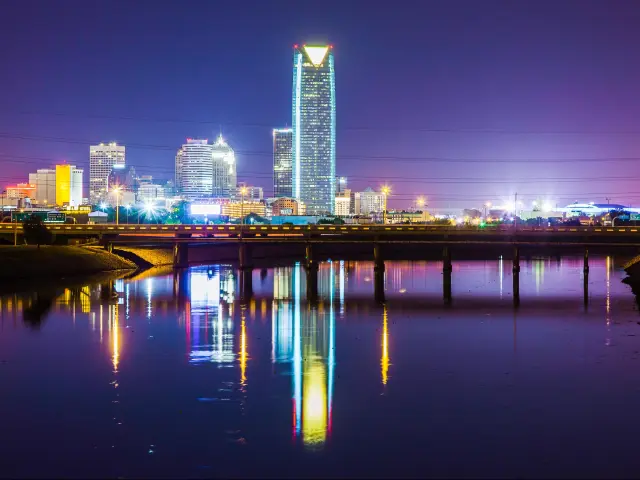
Which route is longer, Route 66 or I-40?
Coming in at 2,180 miles, Route 66 is nearly 400 miles shorter than I-40. If you stick to the interstate all the way then Route 66 can also be the quicker route to drive, at around 33 hours plus 3 to 4 hours for rest stops - driveable in three long days.
However, there are a few more things to take into account when considering whether Route 66 or I-40 is the longer route.
It takes around 37 hours of non-stop driving to travel from one end of I-40 to the other, but allowing for rest stops every 3 hours and one longer break for lunch each day and you'll need to factor in around 43 hours on the road.
You could drive the whole of I-40 in just under 4 days if you don't stop to explore attractions nearby. If you visit all the major cities along the way and stop to enjoy some of the outdoor attractions too, this could easily fill a 2-week road trip.
In comparison, if you leave the interstate and follow the original alignment of Route 66 as faithfully as possible it will take around 50 hours to drive non-stop. That's because the route follows smaller highways and sometimes local roads so you'll have to take this trip at a slower pace compared to I-40.
Stopping every 3 hours with a longer meal stop once per day would add 5 to 7 hours , depending on how long you stop for – a total of 55-57 hours, which you should allow at least 5 days to drive. Realistically, most people will take longer than this for the route though, to allow more time to visit places along the way.
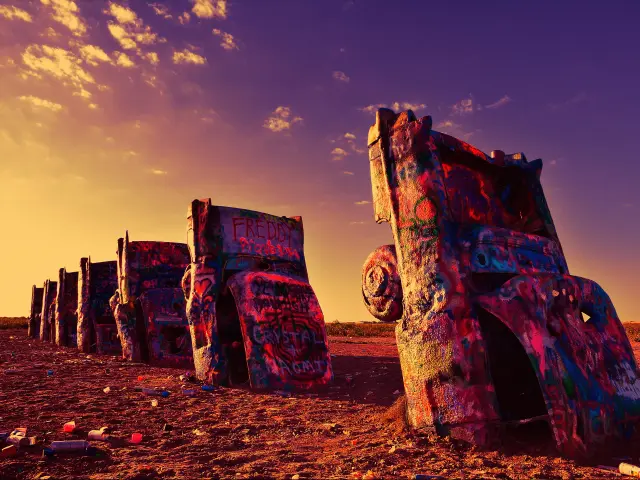
Is Route 66 more interesting than I-40?
Route 66 is an iconic route that's helped shape the modern United States, but does that make it a more interesting route than the more modern Interstate 40?
Route 66 technically doesn't even exist anymore, but, made famous through cult classics, its legend lives on so strongly that travelers still follow what's left of the route.
You can take your pick of Route 66-related attractions if you drive the whole length of the original highway. Almost every state that the road traveled through now has a Route 66 museum, including the Route 66 Hall of Fame in Pontiac, IL, and the National Route 66 Museum in Elk, OK.
Some sections of the former route have now become monuments in their own right. There's the Chain of Rocks Bridge, which used to take Route 66 across the Mississippi outside Madison, IL and the riverside Route 66 State Park in Eureka, MO.
Other attractions along Route 66 range from Hispanic heritage in Albuquerque's Old Town to modern art at Cadillac Ranch outside Amarillo. There's also the Route 66 Car Museum in Springfield, MO, if you're interested in finding out more about the vehicles that would have taken this trip in times past.
Of course, you'll also have the chance to visit the vibrant cities of Chicago and Los Angeles when you travel Route 66, not to mention dipping your toes in the Pacific Ocean when you finally reach the end of the road.
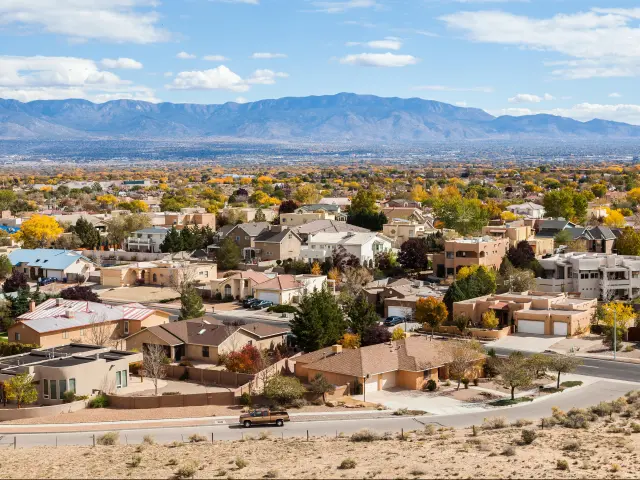
As you've already read, I-40 follows the route of Route 66 closely. That means you'll get the opportunity to stop off at many of the same attractions as you travel between California and Oklahoma, you might just feel a little less immersed in the experience.
Although it's a short drive away from the interstate, the Grand Canyon is a fabulous place that features on many I-40 itineraries. As you continue across the country the road also takes you past Petrified Forest National Park where you'll find the stunning Painted Desert.
You'll also pass through Albuquerque and Amarillo on I-40 which, aside from their Route 66 attractions, have plenty to recommend them ranging from museums to natural attractions. You can also detour north from Albuquerque to visit Los Alamos, where the atomic bomb was developed, and the state capital Santa Fe.
Carrying on east from Oklahoma you soon reach Tennessee, where the Music Highway takes you through the vibrant cities of Memphis, Nashville and Knoxville. Music fans can catch a live show or three as well as visit sites connected to music legends including Elvis Presley and Johnny Cash.
After a stunning drive through the Appalachians, you'll also pass through the university cities of Durham, Raleigh and Chapel Hill, where you'll find a selection of fantastic museums.
As you can see, both routes have plenty to recommend them. They're both so varied and take you through so many amazing places that you'll have an interesting drive whichever route you decide on.
Does Route 66 have better scenery than I-40?
With both routes taking you more than 2,000 miles across the country, one of the great things about these long drives is that they both let you see some stunning and changing scenery.
The wide-open desert landscape of the southwestern United States is probably one of the first things that spring to mind when you picture an iconic long-distance road trip, and this is a big feature of both Route 66 and I-40 as you travel between Oklahoma and California.
In fact, it's such a big feature that if you're driving the whole route, the excitement you feel when you first start to drive across this stunning landscape might start to dwindle after a few hundred miles.
Starting in California, you'll pass Mojave National Preserve on both routes. Turn off to follow the road through the desert for a few miles and you'll be able to enjoy some more amazing scenery.
Technically on Route 66 but also just a short drive away from I-40, Amboy Crater is what's left of a huge volcano, rising up from the flat land that surrounds it, and is an impressive sight.
Both routes also give you a chance to visit some stunning national parks and state parks though, so you'll be able to stop and enjoy some really spectacular scenery.
If you're looking for a little color after all that desert driving, turn south from Flagstaff to visit Coconino National Forest, where the red rock and green forest make for a fabulously scenic drive. You can also stop and hike here if you'd like to spend a little longer enjoying the scenery.
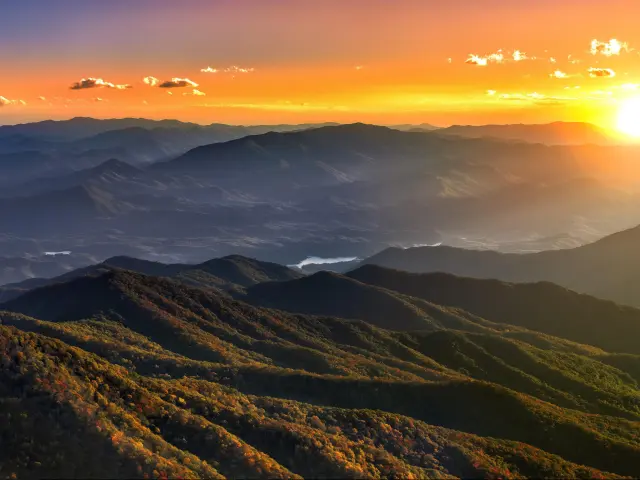
You can easily detour to visit the Grand Canyon of course, or head to Palo Duro Canyon State Park in Texas which is also a vast and scenic natural wonder.
Stop off at Petrified Forest National Park in New Mexico, which is right by the interstate, and you'll be able to visit the Painted Desert. You have to leave the main route to enjoy the best views but it's definitely worth the short detour.
From Oklahoma City north, the Route 66 landscape becomes a little less spectacular. You'll be passing through some very long, very straight stretches of farmland. It's all an important part of the Route 66 story though, as many farming families traveled west on Route 66 to escape the Dust Bowl of the 1930s.
Like many interstates, long stretches of I-40 are tree-lined, making it hard to see the stunning nearby scenery, but east of Oklahoma, I-40 really comes into its own if you have time to stop and explore places you'll pass by.
You can head out into the Ozarks to enjoy the stunning landscape of forests, hills and lakes, or travel a little way along the beautiful Natchez Trace Parkway.
One of the main attractions of this part of the route is the chance to travel through the Great Smoky Mountains National Park. It's a really beautiful part of the drive even if you don't have time to stop and explore the national park.
Where can I take the best photos, Route 66 or I-40?
As you've already read, both Route 66 and I-40 will give you plenty of opportunity to snap some pictures of the open road as you make your way across long, straight stretches of desert.
If you're following Route 66, the section between Kingman and Seligman also takes you to some fabulous small towns which major in vintage Americana, so you'll be able to take some amazing photos on this part of the route.
Both routes take you close to Meteor Crater National Landmark too, a unique sight that will really test your photographic skills in capturing the size and scale of the crater in just the right light.
If you're interested in more urban photography, there are some real highlights on both routes. Albuquerque's old town and historic buildings will feel like a whole continent away from the sparkling ocean views you might snap at the end of Route 66 in Santa Monica.
Carry on along I-40 and you'll be able to catch the neon wonderland of Memphis's Beale Street on camera too, as well as some of the iconic rock and country venues in Nashville and Knoxville.
Which route is easier to drive, Route 66 or I-40?
There's no avoiding the fact that, if you're committed to following the original route of Route 66 as accurately as possible, this is going to make the route a little harder to drive. While some states have made it easy to follow the Mother Road, signage can become much less clear in places.
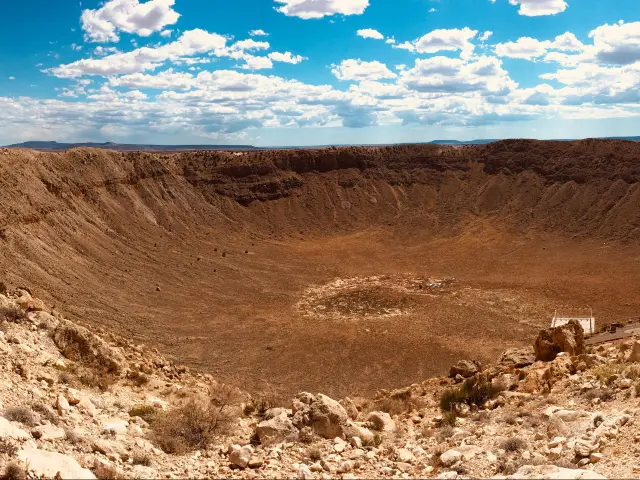
Taking smaller roads, sometimes through the desert or other uninhabited areas, also means you might feel isolated at times. Travel with a cell phone and make sure your vehicle is in good condition to avoid being stranded.
There are also a few parts of Route 66 that will test your driving skills and possibly your nerves. The Oatman Highway (which crosses Sitgreaves Pass) is a particular challenge as it's a steep road with sections in poor condition. There are no guard rails and some steep drop offs.
On both routes, traffic can also make your drive less enjoyable. Los Angeles and Chicago are both busy cities where congestion should be expected.
If you're following the original route through smaller cities and towns, you'll have to navigate slower speed limits and regular local intersections so your drive will be a little more stop-start.
Long sections of both routes cross sparsely populated rural areas of Oklahoma, Texas and New Mexico – expect light traffic in these areas, although construction work and adverse weather may cause delays.
Some travelers might worry about driving the more isolated rural sections of the road late at night, especially crossing Texas, New Mexico and Oklahoma. However, even at night you can expect other passing vehicles so you won't be completely alone on the road.
The eastern half of I-40 connects the major cities of Tennessee and North Carolina, and congestion is more likely around the cities, especially Knoxville which has the most heavily used section of the whole route. At peak visitor times there might also be delays approaching the exit for Great Smoky Mountains National Park.
As well as regular interstate traffic, I-40 is also well used by long-haul truck drivers – always pass safely and be prepared for some busier stretches.
Busy sections of I-40, particularly through Tennessee, see a high number of serious collisions and many fatalities so stay alert. It's always sensible to make sure you're well rested - don't be tempted to drive tired to cover a few extra miles.
Does Route 66 have better facilities than I-40?
If you stick to the interstate there will be places to stop regularly for food and fuel on Route 66, although these might require you to divert into towns near the road.
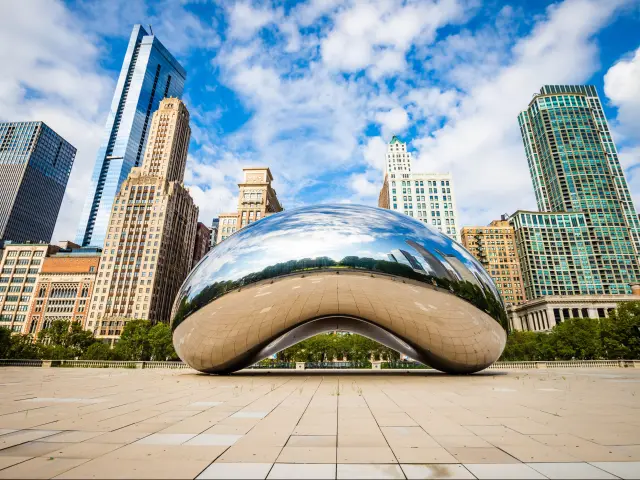
There are regular gas stations along the route, but keep an eye on local signage as there are some long gaps especially as you travel through Arizona, New Mexico and Texas on both Route 66 and I-40. Try not to let your tank go below a quarter full.
Hop off the interstate to follow historic sections of the route and you can enjoy stopping in local restaurants and diners. The section of the route between Seligman and Kingman is a particular highlight, as many of the establishments have made a feature of their Route 66 heritage.
On both routes, EV charging points tend to be found near the major cities along the interstate and there are some long stretches without a public charging point. This is the case for I-40, I-44 and I-55 which the route of Route 66 most closely follows.
There are some long gaps between public charging points in the section between California and Oklahoma City, so plan this part of your EV drive carefully if applicable. There are more charging points between Oklahoma and North Carolina if you're completing your trip on I-40.
With over 2,500 miles of road it's inevitable that even on the interstate, some sections will be better maintained than others, and winter weather can impact on the road surface.
If you're taking Route 66 you'll encounter some sections of road in need of maintenance as most sections of the historic road have been downgraded. The road towards Amboy is currently closed while it awaits repairs.There are no toll roads on I-40, although it does connect with toll roads including the Triangle Expressway in Durham, the Indian Nation Turnpike and the Muskogee Turnpike (both in Oklahoma). If you're taking I-44 to follow Route 66 through Oklahoma, you'll encounter toll roads
Which route has better accommodation options, Route 66 or I-40?
With so many miles to cover, you're going to need to find places to stay on both Route 66 and I-40. You'll find many chain hotels and motels close to the interstate, but it's also possible to seek out more characterful options for a memorable stay that suits your budget.

The bonus of following Route 66 is that you'll have several opportunities to stay at vintage-themed motels, to really immerse yourself in the feel of the route.
One of the best is Historic Route 66 Motel in Seligman, where the regeneration of Historic Route 66 began. It's packed full of Route 66 memorabilia and close to the popular Roadkill Café.
If you're planning a more luxurious Route 66 road trip, then check out the fabulous Hotel Chaco in Albuquerque. It's chic and spacious with a fabulous rooftop bar and outdoor pool, plus it's within walking distance of Old Town and many of the city's museums.
One of the great things about I-40 is that it connects some really buzzing cities, and you can stay in style if you take this route too. Dream Nashville is a real experience, a super-stylish boutique style hotel where art deco features run right the way through the historic building.
If you're trying to keep your road trip costs lower, then a great choice while you're in Memphis is Flora House Denver, a comfortable, stylish B&B, close to major attractions.
This gorgeous old house is tastefully refurbished, with attentive hosts, and pretty outdoor terrace when you can enjoy the views and BBQ facilities. A tasty buffet, continental or vegetarian breakfast is also available every morning to start your day off right.
Comparing Route 66 and I-40 by season
Both Route 66 and I-40 can be driven all year round, but with significant seasonal variations. Severe weather can roll in during winter or the hurricane season.
The southern part of both routes, between California and Oklahoma City, can be extremely hot in summer, with snow and ice possible along much of the route in winter.
Route 66 vs I-40 in spring
Wildflowers can bloom in the desert in spring, making this a colorful time to take the trip between California and Oklahoma on either Route 66 or I-40.
Parts of the I-40 route see heavy rainfall in spring so exploring the Great Smoky Mountains or the Ozarks may be unpredictable. On the plus side, the greenery will be bursting into life and crowds will be much less.

Route 66 vs I-40 in the summer
The section across the Mojave Desert through California and on across Arizona, New Mexico and Texas - where Route 66 and I-40 run closest together - can get very hot in summer, with temperatures exceeding 100 degrees F.
The higher altitude section through Flagstaff is usually cooler, in the 80s.
Late summer through fall is hurricane season, and the eastern end of I-40 around Wilmington can be affected. Look out for local advisories if you're traveling at this time of year.
Route 66 vs I-40 in the fall
Fall is a great time to travel along I-40. It's a really popular time to visit Great Smoky Mountains National Park while the foliage is changing, and if you're carrying on along the route towards California then you can enjoy mild weather in the cities.
Temperatures sit in the low 70s F in Amarillo and Nashville, while it's a little cooler up in Flagstaff and warmer in Barstow, so you avoid the harsh summer heat. Whilst Route 66 isn't known for its fall scenery, temperature-wise this can be a great time to travel this route too.
Route 66 vs I-40 in winter
You'll probably picture blue skies and warm weather on the California to Oklahoma stretch of Route 66 and I-40, but even in the desert, snow and ice are possible in winter. This can work in your favor - a detour to the Grand Canyon to see the landscape transformed by snow and ice can be spectacular.
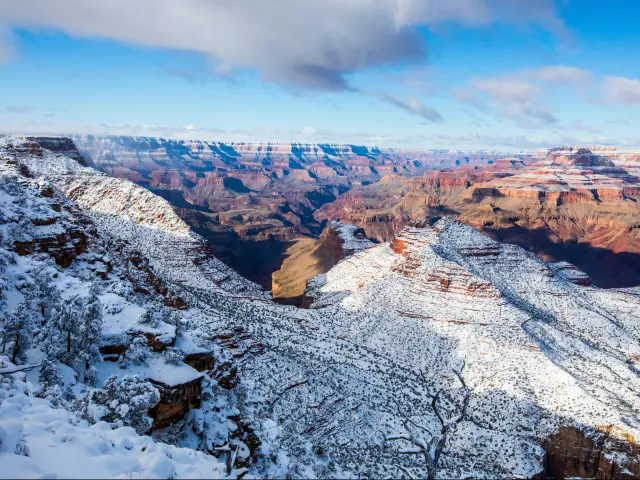
The high-altitude section through Flagstaff is a particular risk on the southern part of Route 66, then as the route starts to head north up to Chicago you should expect temperatures to plummet.
If you're following Route 66 via the interstate then you shouldn't hit too many problems, but if you're following the historic or old highway sections, you're more likely to encounter closures in the winter as these roads are less likely to be cleared.
Snow is possible along much of the I-40 route too, especially through Tennessee, where you can admire the Great Smoky Mountains in the snow. The only downside is that smaller roads may be blocked or closed for the winter, so you won't be able to head out and explore as much as you'd like.
Whichever route you take, the interstate is usually kept clear but it's best to wait out any snowstorms – book an extra night in a hotel if you have to, and wait for the storm to pass before the snowplows head out.
Planning a road trip to Route 66 or I-40
One of the great things about both Route 66 and I-40 is that you can start or end your drive part-way along the route and still enjoy a fantastic road trip.
You can even link up your iconic cross-country drive with another road trip as you travel towards the route from your starting city. Below you will find popular road trips on Route 66:
| Starting city | Via road | Distance | Driving Time |
|---|---|---|---|
| Las Vegas | US-93 | 105 miles | 1 hour 45 minutes |
| Phoenix | I-17 | 145 miles | 2 hours 10 minutes |
| Dallas | I-35 | 230 miles | 3 hours 30 minutes |
| Indianapolis | I-70 | 240 miles | 3 hours 40 minutes |
| Tuscon | I-17 | 255 miles | 3 hours 45 minutes |
| Cleveland | I-90 | 345 miles | 5 hours 20 minutes |
| Denver | I-25 | 445 miles | 6 hours 30 minutes |
| New York | I-80/90 | 790 miles | 12 hours |
Even though Route 66 and I-40 run parallel in parts, the distances from major cities to these routes differ where they diverge. Here is a list of popular road trips on I-40 from major cities in the US:
| Starting city | Via road | Distance | Driving Time |
|---|---|---|---|
| Las Vegas | I-15 | 115 miles | 1 hour 50 minutes |
| St Louis | I-55 | 285 miles | 4 hours 15 minutes |
| Savannah | I-95 | 300 miles | 4 hours 30 minutes |
| Washington DC | I-95 | 300 miles | 4 hours 40 minutes |
| Chicago | I-55 | 530 miles | 8 hours |
| New York | I-95 | 525 miles | 9 hours |
| Orlando | I-75 | 690 miles | 10 hours 15 minutes |
Which route is the best, Route 66 or I-40?
Both routes let you experience the thrill of an epic American road trip, and the two routes are very similar between California and Oklahoma City, so you can effectively combine the drives until this point to enjoy the best of both.

Along the way you can venture off the interstate to follow Historic Route 66 in Arizona to get a real sense of adventure and admire desert views at a slower pace. You'll still see the deserts from the interstate though if you stick to I-40.
The eastern half of I-40, where it separates from the old Route 66, takes you across the Mississippi and through the Appalachians – a much more scenic landscape than the northern part of Route 66 up to Chicago.
I-40 is also easier to follow, given that you have to work hard to stick to the route of Route 66 in places. However, it can also be congested so if you prefer to avoid interstate driving then Route 66 will be the easier drive.
For the most scenic option which maximises attractions, follow Route 66 from California to Oklahoma City, sticking to Historic Route 66 sections where possible, then continue on I-40 to enjoy the Music Highway through Tennessee and stunning mountain scenery.
Or, if you want to stay faithful to the Route 66 legend, stick to the historic highway the whole way to Chicago and enjoy spending some time in the Windy City to round off your road trip.





